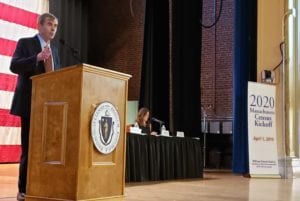Who is a member?
Our members are the local governments of Massachusetts and their elected and appointed leadership.

Secretary of the Commonwealth William Galvin speaks at a 2020 Census kick off event on April 1 in Framingham. (photo courtesy Marion Davis, Massachusetts Immigrant and Refugee Advocacy Coalition)
April 1 marked one year until the 2020 federal census, a constitutionally mandated, decennial count of every individual in America and where they reside.
In Massachusetts, the date was marked by a kickoff event in Framingham hosted by Mayor Yvonne Spicer and led by Secretary of the Commonwealth William Galvin, the state’s liaison to the U.S. Census Bureau for the 2020 count.
Galvin told an audience of state and local officials, advocacy groups and the public that the state faces an “enormous challenge” in getting an accurate count, particularly with its large population of immigrants, college students, renters and the elderly.
“We can be proud of the diversity we have,” he said. “We can be proud of the fact that we have so many institutions that service so many people. We can be proud of our economy. But to keep it sustained and growing over the next 10 years, this critical exercise must be successful.”
Data collected during the federal census determines federal funding for the state and its communities, representation in Congress, and each state’s number of Electoral College votes. The data also inform planning decisions at the local level, such as where to provide services for the elderly, build new roads and schools, or locate job training centers.
To raise awareness and educate communities to promote an accurate count, Galvin has established the 2020 Statewide Complete Count Committee, a group of state agencies and advocates that includes the MMA.
At the Framingham event, Jeff Behler, director of the U.S. Census Bureau’s regional office for the Northeast, pointed out that, for the first time, residents in 2020 can fill out the census online. He said postcards will be sent to residents asking them to use the online option. If they don’t respond, they will also be sent a paper form. The third and fourth options are a phone call or a visit from a census taker.
Behler said organizations will be able to host events where people can fill out the census online, as well as “call-a-thons” where residents can call a toll-free number to answer the census questions.
Statewide Complete Count Committee Chair Eva Millona, executive director of the Massachusetts Immigrant and Refugee Advocacy Coalition, expressed concerns about a proposed citizenship question on the census that could have “a chilling effect” on immigrant populations, who are already historically undercounted.
All residents, she said, must be reminded that federal law forbids the Census Bureau from sharing their answers with other government agencies, including local, state and federal law enforcement.
“Having someone from the government come to your door and asking all kinds of personal questions could be terrifying if we do not prepare the households,” she said.
A Supreme Court ruling is expected in June to determine whether the Trump administration violated federal law when it proposed adding the citizenship question.
Three of the last four federal census counts resulted in Massachusetts losing a congressional seat because its population grew at a slower pace than other states.
Galvin has said that Massachusetts currently has an estimated population of 6.9 million, up from the official 6.54 million count in 2010, which makes the loss of a congressional seat unlikely. He said the challenge is to ensure that the census upholds the estimate.
NLC offers help
Also on April 1, the National League of Cities unveiled a host of census resources for local leaders, including a “Municipal Action Guide.”
The NLC is advising municipal leaders to begin immediately to lay the groundwork for a successful census and recommends the following steps:
• Designate a point of contact for census preparedness in your community to help ensure consistent communication to the public. The NLC urges local census contacts to join its Local Census Preparedness Network by completing a survey.
• Work with U.S. Census Bureau staff, regional offices and field offices to ensure coordination across levels of government. Respond to bureau inquiries and share data to identify hard-to-count neighborhoods in your community.
• Engage the trusted voices in your community. Residents need to hear from people they trust: educators, small business owners, medical professionals, religious leaders, community activists and local media.
• Form a local volunteer complete count committee to engage the community and provide information and motivation to residents. Notify the Census Bureau if your community forms a complete count committee.
A local complete count committee might include elected officials, religious leaders, parents, teachers and representatives from various municipal departments.
Resources
U.S. Census Bureau: www.census.gov
NLC census resources: www.nlc.org/census
Secretary Galvin’s census website: www.sec.state.ma.us/census2020
Complete Count Committee Guide: www.sec.state.ma.us/census2020/img/pdf/2020-Census-Complete-Count-Committee-guide.pdf